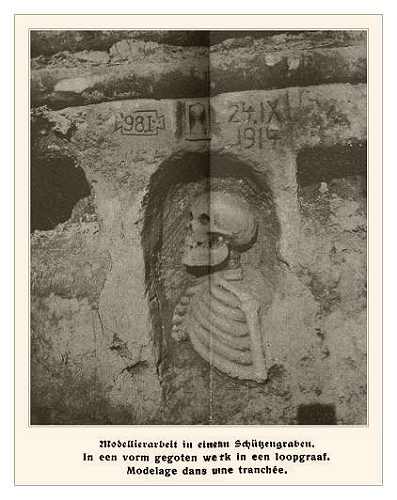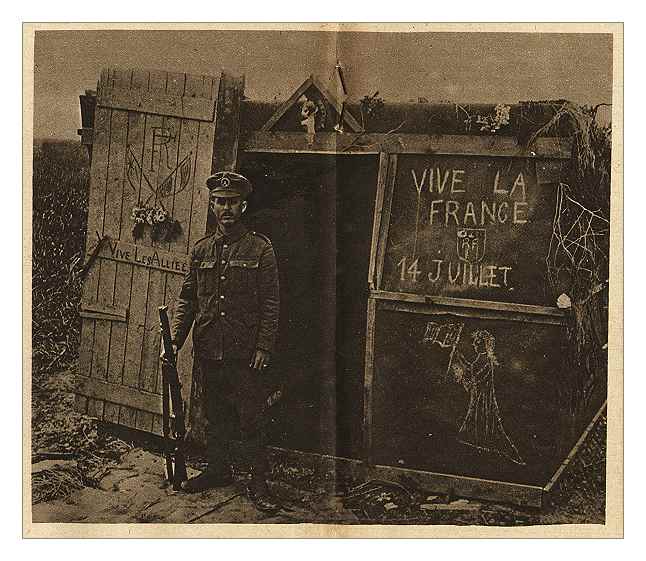


'Grafitti and Trench Art'



Whittling Away the Long and Dreary Hours


Grafitti and individual soldier's markings or doodles, by their very nature were of course not considered to be 'art' of any kind during the Great War, so it is scarce wonder that it is difficult to find any contemporary photographs of such material. Nevertheless every now and then something can be found, though in such cases the grafitti is of the more sophisticated kind, making it newsworthy in some manner or another.
In the early days of the war, especially on troop trains, messages and crude designs were often chalked on railway-carriages complete with slogans such as 'Von Berlin, uber Metz nach Paris' or perhaps in the opposite direction. Dug-outs and underground shelters were often decorated with more or less skillfully drawn caricatures or scenes of the enemy being booted on the backside or humiliated in one way or another. It goes without saying that soldiers being soldiers, some of the grafitti could be quite crude, ribald and obscene. Photos of such material of course never found its way into newsmagazines, even by accident, but after the war several photos, presumably from private collections were published in various scientific and anti-war books.
Aside from chalking, etching, engraving or painting grafitti on any kind of flat surface available, soldiers also passed the time making what is now referred to as trench art. This trench art generally consisted of decorating disused or salvaged items of war (such as shell casings large or small, bits of barbed wire, flattened metal objects and heavens knows what else). Some of the objects created in this manner were quite decorative in their own right and at times ingenious as well. Chess sets were a favorite item, as well as vases, rings, pendants, plaques, pens, lamps, knives, letter openers and holders, can openers, napkin rings, toy statues, candleholders, pipes, musical instruments (see Soldier's Orchestras) and the ever-popular ships-in-a-bottle. An all-time favorite were lighters. Before and during the war, the French government imposed a tax on all methods of making fire, by taxing matches or lighters, but soldiers obviously did not feel like paying for what they considered the basic right to make a fire or light a cigarette while on duty in war-time. Disputes about this tax on lighters became quite heated and in a rare show of decency, the French government later absolved all authentic soldier-made lighters of any fiscal duties.
Nowadays trench art is very much sought after, though by its very nature of being knick-knacks made just to pass the time away, it was readily discarded or lost during the great upheavals of the war itself.
Decorated shell-casings can be found more easily, but it must be said that even up to the 1950s in the Ypres region, there were still small manufactories turning out 'authentic' decorated casings that were sold to tourists as the genuine article. It's true that the shell-casings generally were authentic, there being an abundance of unused and buried ordenance still about, but the art-work was not from the time of the Great War itself. During the war itself, it seemed that many a small businessman or manufactory were not above mass producing 'trench art' rings, jewels or lighters. These were often sold to shops catering to tourists or soldiers on leave, who could then cheaply pick up an 'authentic' bit of trinketry to present to sweetheart, wife, friends or family while on leave.
note the stone carving of a French zouave on the quarry rock-face
sculpturing in the trenches
French soldiers at work with shell casings and metal parts
During the war, the French newsmagazine 'Le Pays de France' organised a trench art contest. Soldiers were encouraged to send in their creations which would then be judged by a no doubt learned panel of experts, according to their artistic or other intrinsic merits. Cash prizes were then awarded to the winning entries. During the contest, the newsmagazine ran up to several pages of photos each week of some of the more photogenic items. These at times very attractive objects along with the list of winners and their creations can be seen in several of the links below.

from a French magazine : 'Pages de Gloire' - making lighters for use in the trenches

from a French magazine 'le Miroir'
from a war-time book
"Our next visit was to a sod-thatched hut, "At the sign of the Ambulant Artisans," where two or three soldiers were modelling and chiselling all kinds of trinkets from the aluminium of enemy shells. One of the ambulant artisans was just finishing a ring with beautifully modelled fauns' heads, another offered me a "Pickelhaube" small enough for Mustard-seed’s wear, but complete in every detail, and inlaid with the bronze eagle from an Imperial pfennig.
There are many such ring-smiths among the privates at the front, and the severe, somewhat archaic design of their rings is a proof of the sureness of French taste; but the two we visited happened to be Paris jewellers, for whom "artisan" was really too modest a pseudonym. Officers and men were evidently proud of their work, and as they stood hammering away in their cramped smithy, a red gleam lighting up the intentness of their faces, they seemed to be beating out the cheerful rhythm of I too will some-thing make, and joy in the making."
- a description of a visit to the Lorraine front in 1915
- by Edith Wharton from her book ‘Fighting France’
To Illustrations
To Texts


hand colored photos of caricatures painted on French army tents